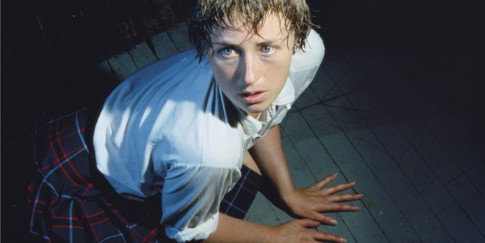
Cindy Sherman, Untitled #93, 1981 © Cindy Sherman. Courtesy of the artist and Metro Pictures, New York
The Mini Cinema
NYC 1980s
New York in the 1980s was a harsh city with a dynamic arts scene. Cindy Sherman moved there in summer 1977, after graduating from art school in Buffalo, and the city came to impact on her work. She soon became part of a circle of artists, musicians and filmmakers who set the tone on the art scene. Important venues were the artist-run Artists Space, where Cindy Sherman worked for some time, and The Kitchen, a centre for video and performance art. This series of films introduces us to a few prominent characters on the 1980s New York art and music scene, of whom several have a direct link to Sherman and her work. Some of the features are productions from a time when artists and curators were experimenting with new ways of presenting art for TV.
Curator: Lena Essling
IN THE MINI CINEMA
Cindy Sherman: An interview
MICA-TV
1980-1981, 10:20 min, colour, sound
Set to a muzak soundtrack, Cindy Sherman talks about her oeuvre in an interview for MICA-TV’s Carole Ann Klonarides. Together, they go through a portfolio of Untitled Film Stills and other early works. During the interview, both Sherman and the studio background are transformed. MICA-TV was a collaboration between Carole Ann Klonarides and Michael Owen. Their programmes were based on the concept that viewers could learn more about artists by seeing the artist’s ideas visualised in a different medium.
Producers: Carole Ann Klonarides, Michael Owen.
Laurie Simmons: A Teaser
MICA-TV
1982, 5 min, colour, sound
Laurie Simmons’ images are brought to life in MICA-TV’s portrait of the photographer. In the early 1980s, Simmons was working on subaqueous photography of women, inspired by Esther Williams’ water ballets. We see Simmons photographing under water in a swimming pool. The models are friends of the photographer. One of them is Cindy Sherman.
Producers: Carole Ann Klonarides, Michael Owen. Music: Mark Bingham.
From an Island Summer
Charles Atlas (b. 1949)
1983-1984, 13:04 min, colour, sound
Charles Atlas follows the choreographer Karole Armitage and her dancers during a couple of August days along the beach walk on Coney Island and the streets around Times Square. With a hand-held camera, he portrays their dance in the visual cacophony of the settings. To a soundtrack of samba and punk-inspired music, he delivers an energetic portrait of New York in sweltering heat.
The video artist and film director Charles Atlas is a pioneer of dance and performance in video art. He often collaborated closely with choreographers and artists, including Merce Cunningham, Marina Abramovic and Leigh Bowery.
Choreography: Karole Armitage. Director of Photography: Paul Gibson. Music: Henry Fiol, Rabbie Burns and his Ticket Touts.
Difficult Listening Hour
Laurie Anderson (b. 1947)
1986, 2:13 min, colour, sound
The performance artist, composer and musician Laurie Anderson, on the mysteries of language and art music:
Good evening. Welcome to Difficult Listening Hour. The spot on your dial for that relentless and impenetrable sound of Difficult Music. So sit bolt upright in that straight-backed chair, button that top button, and get set.
Followed by an excerpt from Anderson’s unexpected 1981 hit O Superman, on communication, technology and warfare.
From Two Moon July (1986), a multi-disciplinary TV production presenting experimental video, film, visual art, performance and music.
Producer: Carlota Schoolman for The Kitchen. Directed by: Tom Bowes.
Report from LA
David Byrne (b. 1952)
1986, 4:32 min, colour, sound
The Musician, composer and front man of the new wave band Talking Heads (1975-91) reports from Los Angeles, the movie city. An appearance filmed at The Kitchen, among works by Cindy Sherman, Robert Longo and other artists.
From Two Moon July (1986), a multi-disciplinary TV production presenting experimental video, film, visual art, performance and music.
Producer: Carlota Schoolman for The Kitchen. Directed by: Tom Bowes.
They Are Lost to Vision Altogether
Tom Kalin (b. 1962)
1989, 12:56 min, B/W, sound
Tom Kalin is a pioneer of queer filmmaking. This film alternates between short clips of news reports about aids in the USA, homoeroticism and suggestive imagery. The news flow reflects the political and moral crisis that hit the USA in the wake of the disease in the 1980s. Tom Kalin has called his film “an erotic revenge” for the ensuing legislation that targeted homosexuals, who were already a group that suffered persecution.
As a co-founder of the artist and activist collective Gran Fury (1988-94), Kalin worked to remove the stigma and silence surrounding aids, via advertising and the media. Tom Kalin collaborated with Cindy Sherman on the script for her horror comedy Office Killer (1997).
Camera/Editor/Script: Tom Kalin. On-line editor: Enrique Aguirre. Assistant editor: Alison Kelly. Original music: Chris Cochrane. Voices: Hilton Als, Candy Darling, Kate Farrell, Tom Kalin. Text: Virginia Woolf, The Waves. Additional text: Edward Albee, Tom Kalin, Robert Musil. Additional camera: Donald Moffett. Additional sound: Testing the Limits. Additional music: The Cure, Ella Fitzgerald and the Nice Guys, Grace Jones, Edith Piaf, Astor Piazzolla, Salt-N-Pepa, Nina Simone. Tsk, tsk, tsk Productions.



